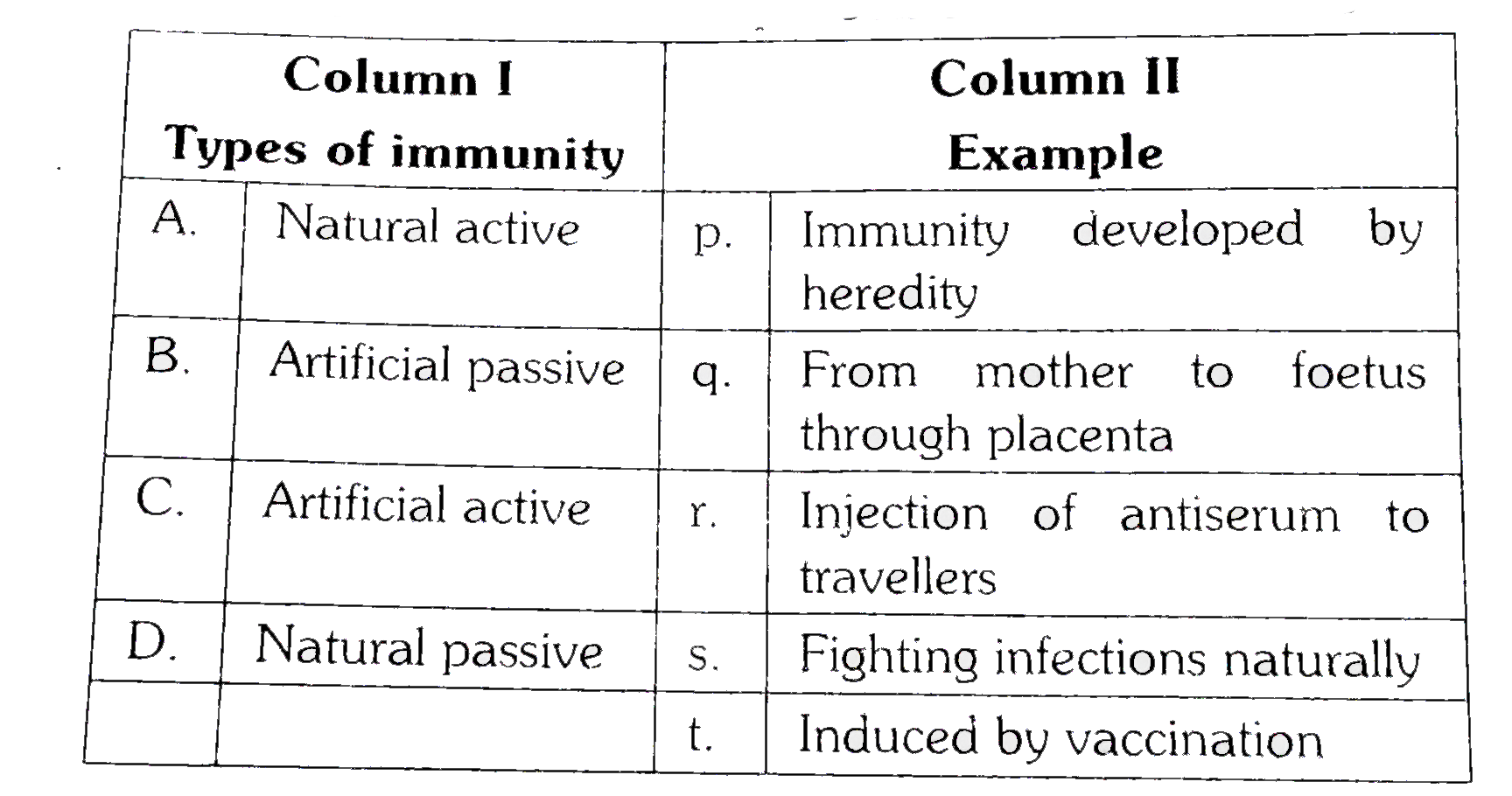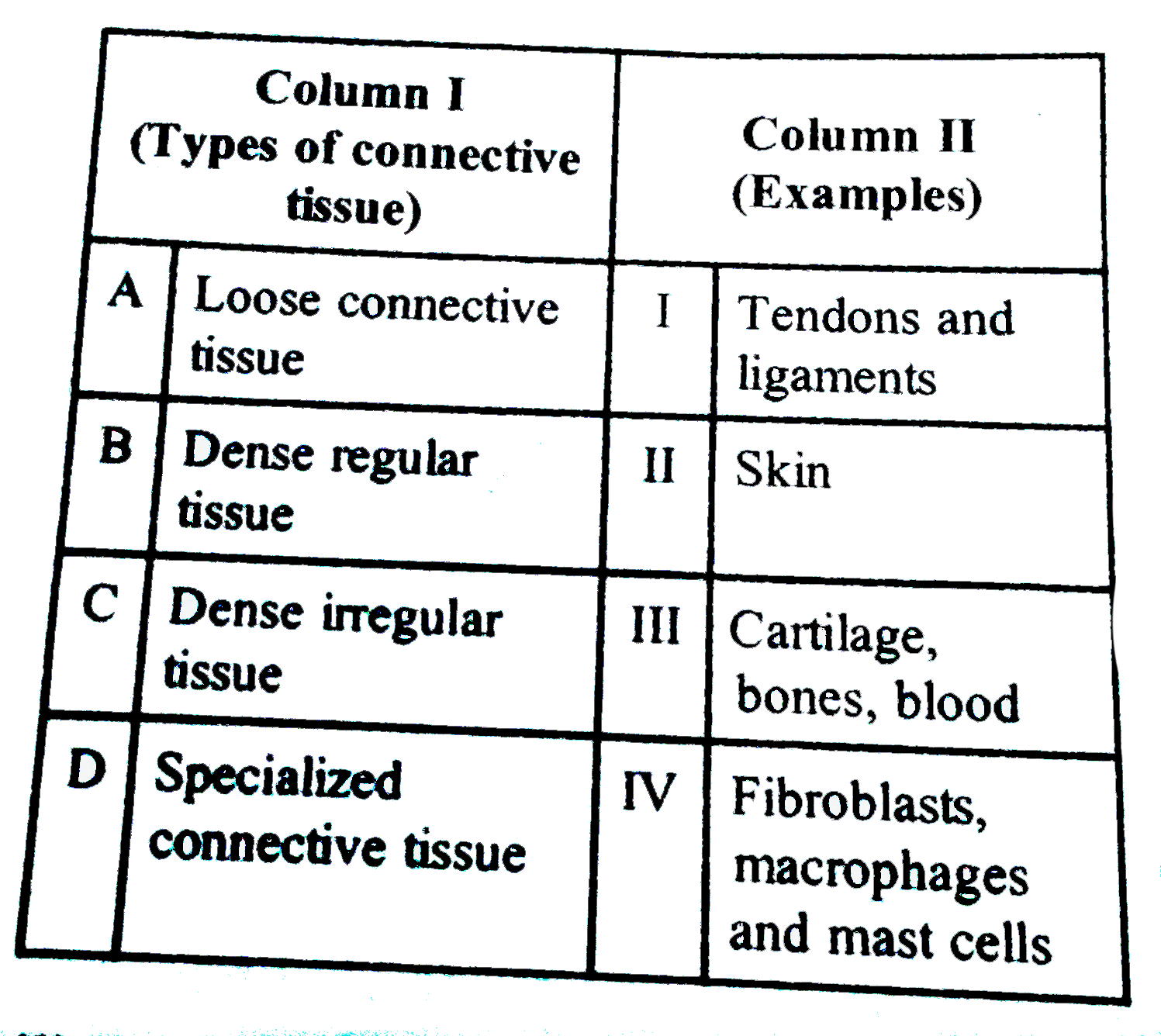Match the type of bacteria listed in column I with their activity given in column II. Choose the correct combination of alphabets of the two columns
∣∣
∣
∣
∣
∣
∣
∣
∣∣Column-I(Types of bacterial)Column-II(Activity)A.Steptomycesp.Food poisoningB.Rhizobiumq.Source of antibioticsC.Nitrosomonasr.Nirogen fixationD.Acetobacters.Nitrificationt.Vinegar synthesis∣∣
∣
∣
∣
∣
∣
∣
∣∣
a - s, b-t, c- p,d-r
a- t, b- p, c-r,d-s
a-q, b-r, c-p, d-t
a-q,b-r,c-s,d-t.
The correct Answer is:D
To solve the problem of matching the types of bacteria with their respective activities, we will analyze each bacterium in Column I and identify its corresponding activity in Column II.
1. Identify the first bacterium: Streptomyces
- Activity: Streptomyces is known for being a major source of antibiotics.
- Match: Therefore, Streptomyces (A) corresponds to Source of antibiotics (q).
2. Identify the second bacterium: Rhizobium
- Activity: Rhizobium is a nitrogen-fixing bacterium that forms a symbiotic relationship with leguminous plants.
- Match: Thus, Rhizobium (B) corresponds to Nitrogen fixation (r).
3. Identify the third bacterium: Nitrosomonas
- Activity: Nitrosomonas is involved in the process of nitrification, where ammonia is oxidized to nitrites and then to nitrates.
- Match: Hence, Nitrosomonas (C) corresponds to Nitrification (s).
4. Identify the fourth bacterium: Acetobacter
- Activity: Acetobacter is known for converting ethanol into acetic acid, which is used in vinegar production.
- Match: Therefore, Acetobacter (D) corresponds to Vinegar synthesis (t).
5. Summary of Matches:
- A - q (Streptomyces - Source of antibiotics)
- B - r (Rhizobium - Nitrogen fixation)
- C - s (Nitrosomonas - Nitrification)
- D - t (Acetobacter - Vinegar synthesis)
Final Matching:
- A: q
- B: r
- C: s
- D: t
- Activity: Streptomyces is known for being a major source of antibiotics.
- Match: Therefore, Streptomyces (A) corresponds to Source of antibiotics (q).
- Activity: Rhizobium is a nitrogen-fixing bacterium that forms a symbiotic relationship with leguminous plants.
- Match: Thus, Rhizobium (B) corresponds to Nitrogen fixation (r).
- Activity: Nitrosomonas is involved in the process of nitrification, where ammonia is oxidized to nitrites and then to nitrates.
- Match: Hence, Nitrosomonas (C) corresponds to Nitrification (s).
- Activity: Acetobacter is known for converting ethanol into acetic acid, which is used in vinegar production.
- Match: Therefore, Acetobacter (D) corresponds to Vinegar synthesis (t).
- A - q (Streptomyces - Source of antibiotics)
- B - r (Rhizobium - Nitrogen fixation)
- C - s (Nitrosomonas - Nitrification)
- D - t (Acetobacter - Vinegar synthesis)
- A: q
- B: r
- C: s
- D: t
Topper's Solved these Questions
- KINGDOM MONERA (THE PROKARYOTES)BOOK - DINESH PUBLICATION ENGLISHCHAPTER - KINGDOM MONERA (THE PROKARYOTES)EXERCISE - CHECK YOUR GRASP
20 Videos
- KINGDOM MONERA (THE PROKARYOTES)BOOK - DINESH PUBLICATION ENGLISHCHAPTER - KINGDOM MONERA (THE PROKARYOTES)EXERCISE - CHECK YOUR GRASP
20 Videos
- KINGDOM FUNGI-MULTICELLULAR DECOMPOSERSBOOK - DINESH PUBLICATION ENGLISHCHAPTER - KINGDOM FUNGI-MULTICELLULAR DECOMPOSERSEXERCISE - CYG
19 Videos
- KINGDOM PLANTAE OR METAPHYTA BOOK - DINESH PUBLICATION ENGLISHCHAPTER - KINGDOM PLANTAE OR METAPHYTA EXERCISE - CYG
20 Videos
Similar Questions
match the types of defect given in column I with the statement given in column II.

View Solutionmatch the types of defect given in column I with the statement given in column II.

View SolutionMatch the type of packing given in column I with the iterms given in column II.

View SolutionMatch the type of packing given in column I with the iterms given in column II.

View SolutionMatch the items given in column I with those listed in column. II choose the answer with the correct combination of the alphabets of the two columns.

View SolutionMatch the type of immunity listed in column I with the examples listed in column II. Choose the answer that gives the correct combination of alphabets of the two columns

View SolutionMatch the phytohormones given in column I with their functions given in column II. Choose the answer with the correct combination of the alphabets of the two-column.

View SolutionMatch the types of connective tissue given in column-I with their examples given in column -II and choose the correct option

View SolutionMatch the reactions given in Column I with the type of reactions given in Column II

View SolutionMatch the scientists present in columns I with their contribution in column II, and choose the correct combination from the option given .

View Solution
